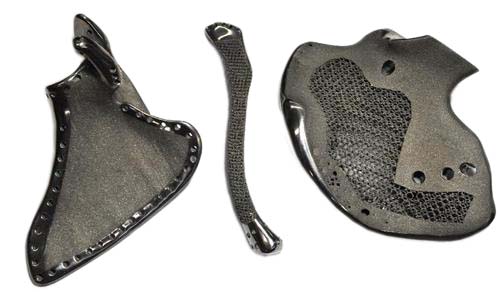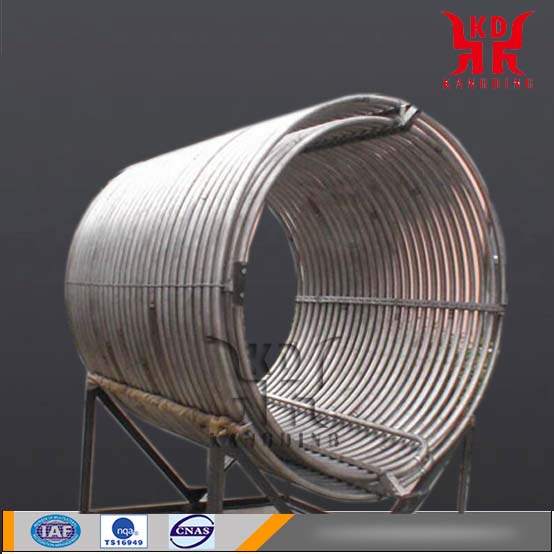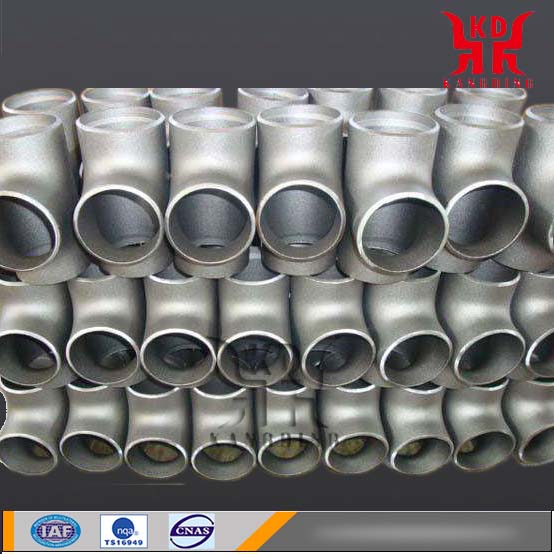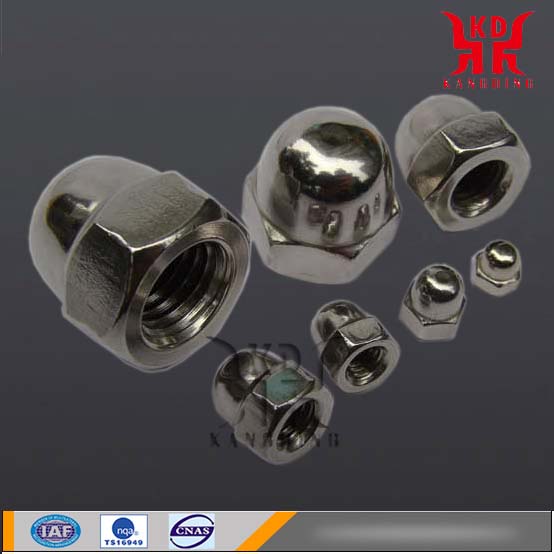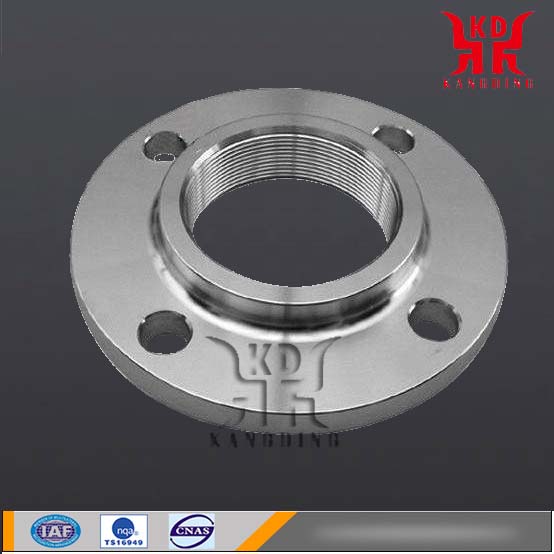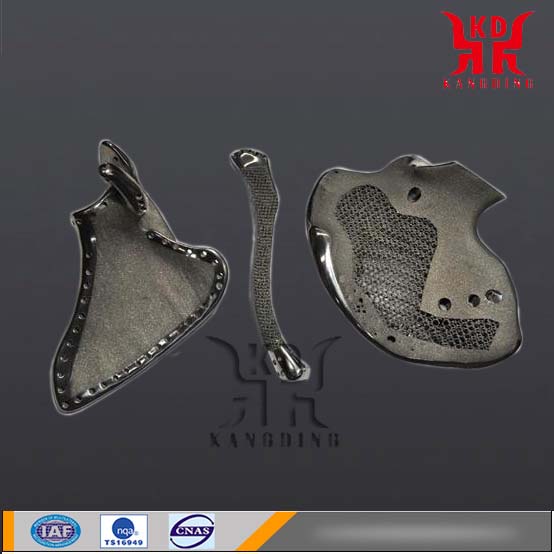Medical titanium alloys are used in the manufacture of titanium alloys implanted in medical devices, prostheses or artificial organs and ancillary treatment devices in the human body.
There are mainly titanium 6 aluminum 4 vanadium, titanium 5 aluminum 2.5 tin and other alloys.
They have high specific strength, mechanical properties close to human bones, and strength far better than that of pure titanium. They also have characteristics such as fatigue resistance, corrosion resistance, and excellent biocompatibility.
Widely used in various artificial joint artificial bone, bone fixation devices, artificial teeth, dental inserts, fixed bridges and so on.
1. Why titanium or titanium alloys are preferred as human implants?
As a biomedical functional material, metal materials are an important branch of materials science and have been used in the history of human implants for more than 400 years.
Early in the UK, pure gold plates were used to repair skulls and dentures, and subsequently fixed fractured joints of silver, iron, iron wire and iron-based alloys were used.
After 1930, the United Kingdom and the United States used a cobalt-based alloy as a human implant. During the Second World War, countries such as the United Kingdom, the United States, and Japan used large amounts of stainless steel as human implants.
Stainless steel is implanted in the human body and people who are allergic to nickel cannot implant 316L or 317L.
In the early 1950s, with the development of the rare metals industry, titanium and niobium and zirconium in the as-processed and as-cast states were used as human implants for clinical trials.
Application Status and Development Trend of Titanium Alloy in Medical Field
Titanium is an important structural metal that was developed in the 1950s. Titanium alloys are widely used in various fields due to their high specific strength, corrosion resistance, and high heat resistance. Many countries in the world have recognized the importance of niobium alloy materials, and have carried out research and development on them, and have been practically applied.
The first practical titanium alloy is the Ti-6Al-4V alloy developed in the United States in 1954. Because of its good heat resistance, strength, plasticity, toughness, formability, weldability, corrosion resistance, and biocompatibility, it has become a trump alloy in the titanium alloy industry. The use of this alloy accounts for 75% to 85% of all titanium alloys. Many other titanium alloys can be regarded as a modification of the Ti-6Al-4V alloy.
From the 1950s to the 1960s, it was mainly the development of high temperature titanium alloys for aircraft engines and structural titanium alloys for the body. In the 1970s, a number of corrosion-resistant titanium alloys were developed. Since the 1980s, corrosion-resistant titanium alloys and high-strength titanium alloys have been further developed. The use temperature of heat-resistant titanium alloys has increased from 400°C in the 50's to 600-650°C in the 1990's. The presence of A2 (Ti3Al) and r(TiAl)-based alloys has caused titanium to be propelled from the cold end of the engine (fan and compressor) to the hot end (turbine) of the engine at the point of use of the engine. Structural titanium alloys develop toward high strength, high plasticity, high strength, high toughness, high modulus, and high damage tolerance.
In addition, since the 1970s, shape memory alloys such as Ti-Ni, Ti-Ni-Fe, and Ti-Ni-Nb have also emerged, and have been increasingly used in engineering applications.
Titanium alloys can be classified into four classes: α, α+β, β-type alloys and titanium-aluminum intermetallic compounds (TixAl, where x=1). Titanium human implants are special functional materials closely related to human life and health. Compared with other metal materials, there are six main advantages of using titanium and titanium alloys:
1. light weight
The density of titanium and titanium alloys is 4.5 g/cm3 at 20°C, which is only 56% of stainless steel. Implantation into the human body has greatly reduced the human body's load, and as a medical device has also reduced the workload of medical personnel.
2. The low modulus of elasticity
Titanium and titanium alloys have low elastic modulus and pure titanium is 10,850 kgf/mm2, which is only 53% of that of stainless steel. Implantation in the human body is closer to the natural bone of the human body, which is beneficial to the bone graft and It can reduce the stress shielding effect of bone on implants.
3 Non-magnetic
Titanium and titanium alloys are non-magnetic metals and are not affected by electromagnetic fields and thunderstorms, which is beneficial to human safety after use.
4 non-toxic
Titanium and titanium alloys are non-toxic and have no toxic side effects on the human body as an implant.
5. Corrosion resistance
Titanium and titanium alloys are known as bio-inert metal materials and have excellent corrosion resistance in human blood soaking environments, ensuring good compatibility with human blood and cell tissues. As the implant does not produce human contamination, no allergic reaction occurs, which is the basic condition for the application of titanium and titanium alloys.
Anodic oxidation treatment is applied on the surface of titanium and titanium alloys for human implants to improve the wear resistance, corrosion resistance, and cyclic fatigue resistance of implants under human conditions. It also solves the problem of dissolution of metal ions to a large extent and improves the compatibility of implants. Also be identified as different specifications of products, to facilitate the surgical procedure.
6. High strength and good toughness
Due to injuries, tumors and other factors that cause bone and joint damage, in order to establish a stable bone support, it is necessary to rely on arc plates, screws, artificial bones and joints, etc. These implants are left in the human body for a long period of time and are subject to bending, twisting, squeezing, muscle contraction, and the like. The implants are required to have high strength and toughness. Research and clinical examples have demonstrated that pure titanium can be used in areas where the human body is under stress, and Ti-6Al-4V alloy can be used in places where the human body is under stress, which can fully meet the requirements of human implants.
The relevant researches in the world and a large number of clinical treatment examples recognize the depth and breadth of titanium and titanium alloys as the most ideal human implant metal materials to date. Is today's medical industry as a surgical Following the stainless steel, cobalt-based alloys emerging third generation of metal. The advantages of medical titanium and titanium alloy materials have been recognized by the medical community and accepted by more and more patients.
At present, the extensive use of Ti-6Al-4v ELI alloys in the medical field will separate out a very small amount of vanadium and aluminum ions, reducing their cell adaptability and possibly causing harm to the human body. This problem has long attracted widespread medical attention. In the United States, as early as the mid-1980s, aluminum-free, vanadium-free, biocompatible titanium alloys were developed for use in orthopedics.
Japan and the United Kingdom have also done a lot of research in this area and made some new progress. For example, Japan has developed a series of α+β titanium alloys with excellent biocompatibility, including Ti-15Zr-4Nb_4ta-0.2Pd, Ti-15Zr-4Nb-aTa-0.2Pd-0.20~0.05N, Ti-15Sn. -4Nb-2Ta-0.2Pd and Ti-15Sn-4nb-2Ta-0.2Pd-0.20, these alloys are superior to Ti-6Al-4v ELI in corrosion strength, fatigue strength and corrosion resistance.
Compared with α+β titanium alloys, β titanium alloys have higher strength, better kerf properties and toughness, and are more suitable for implantation into the human body as implants. In the United States, five beta-titanium alloys have been proposed to the medical field, namely TMZFTM (TI-12Mo-^Zr-2Fe), Ti-13Nb-13Zr, Timetal 21SRx (TI-15Mo-2.5Nb-0.2Si), Tiadyne 1610 (Ti-16Nb-9.5Hf) and Ti-15Mo.
Titanium alloys for the manufacture of medical devices, prostheses or artificial organs and auxiliary treatment devices implanted in the human body. There are mainly titanium 6 aluminum 4 vanadium, titanium 5 aluminum 2.5 tin, ELI titanium 6 aluminum 4 vanadium and other alloys. They have high specific strength, mechanical properties close to human bones, and strength far better than that of pure titanium. They also have characteristics such as fatigue resistance, corrosion resistance, and excellent biocompatibility.
The body does not produce titanium exclusion
First of all, most of the metal will work with oxygen in the air. This phenomenon is oxidation, the rust of the saying. Copper produces copper green. Iron produces rust and so on.
Titanium is highly unstable when it is extremely high temperature. It will grab electrons everywhere, grab electrons and balance itself, then stabilize. Titanium at room temperature, is extremely stable and will not rob others of their own electronic or electrons are taken away. In general, titanium starts to destabilize when it exceeds 600 degrees Celsius.
Because of its highly stable nature, titanium is not easy to chemically change with substances in the body when applied to the human body and is not corroded by acidic substances in the body.
The properties of titanium itself are good, but not perfect. Therefore, we can see that titanium is not pure titanium, but compounds. Only compounds can exist stably at room temperature and do not easily change.
The artificial joints, bone nails, scalpels, and liposuction cannulas that have entered the human body are all made of titanium alloys.
As for the liquefied titanium and titanium carbide that are currently on the market, these are all compounds, not pure titanium. When titanium is combined with different things, it will show different characteristics.
Far as is known, only the liquified titanium and titanium carbide production: Titanium collars, titanium germanium bracelets, titanium necklaces and other products have the function of adjusting the body's health care. The general titanium products do not have this function.
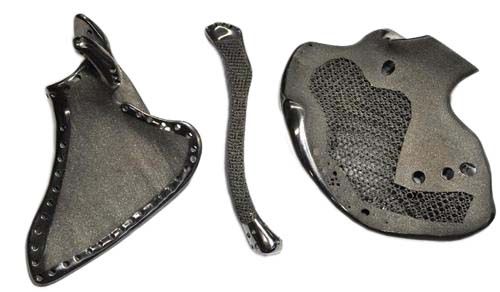
There are mainly titanium 6 aluminum 4 vanadium, titanium 5 aluminum 2.5 tin and other alloys.
They have high specific strength, mechanical properties close to human bones, and strength far better than that of pure titanium. They also have characteristics such as fatigue resistance, corrosion resistance, and excellent biocompatibility.
Widely used in various artificial joint artificial bone, bone fixation devices, artificial teeth, dental inserts, fixed bridges and so on.
1. Why titanium or titanium alloys are preferred as human implants?
As a biomedical functional material, metal materials are an important branch of materials science and have been used in the history of human implants for more than 400 years.
Early in the UK, pure gold plates were used to repair skulls and dentures, and subsequently fixed fractured joints of silver, iron, iron wire and iron-based alloys were used.
After 1930, the United Kingdom and the United States used a cobalt-based alloy as a human implant. During the Second World War, countries such as the United Kingdom, the United States, and Japan used large amounts of stainless steel as human implants.
Stainless steel is implanted in the human body and people who are allergic to nickel cannot implant 316L or 317L.
In the early 1950s, with the development of the rare metals industry, titanium and niobium and zirconium in the as-processed and as-cast states were used as human implants for clinical trials.
Application Status and Development Trend of Titanium Alloy in Medical Field
Titanium is an important structural metal that was developed in the 1950s. Titanium alloys are widely used in various fields due to their high specific strength, corrosion resistance, and high heat resistance. Many countries in the world have recognized the importance of niobium alloy materials, and have carried out research and development on them, and have been practically applied.
The first practical titanium alloy is the Ti-6Al-4V alloy developed in the United States in 1954. Because of its good heat resistance, strength, plasticity, toughness, formability, weldability, corrosion resistance, and biocompatibility, it has become a trump alloy in the titanium alloy industry. The use of this alloy accounts for 75% to 85% of all titanium alloys. Many other titanium alloys can be regarded as a modification of the Ti-6Al-4V alloy.
From the 1950s to the 1960s, it was mainly the development of high temperature titanium alloys for aircraft engines and structural titanium alloys for the body. In the 1970s, a number of corrosion-resistant titanium alloys were developed. Since the 1980s, corrosion-resistant titanium alloys and high-strength titanium alloys have been further developed. The use temperature of heat-resistant titanium alloys has increased from 400°C in the 50's to 600-650°C in the 1990's. The presence of A2 (Ti3Al) and r(TiAl)-based alloys has caused titanium to be propelled from the cold end of the engine (fan and compressor) to the hot end (turbine) of the engine at the point of use of the engine. Structural titanium alloys develop toward high strength, high plasticity, high strength, high toughness, high modulus, and high damage tolerance.
In addition, since the 1970s, shape memory alloys such as Ti-Ni, Ti-Ni-Fe, and Ti-Ni-Nb have also emerged, and have been increasingly used in engineering applications.
Titanium alloys can be classified into four classes: α, α+β, β-type alloys and titanium-aluminum intermetallic compounds (TixAl, where x=1). Titanium human implants are special functional materials closely related to human life and health. Compared with other metal materials, there are six main advantages of using titanium and titanium alloys:
1. light weight
The density of titanium and titanium alloys is 4.5 g/cm3 at 20°C, which is only 56% of stainless steel. Implantation into the human body has greatly reduced the human body's load, and as a medical device has also reduced the workload of medical personnel.
2. The low modulus of elasticity
Titanium and titanium alloys have low elastic modulus and pure titanium is 10,850 kgf/mm2, which is only 53% of that of stainless steel. Implantation in the human body is closer to the natural bone of the human body, which is beneficial to the bone graft and It can reduce the stress shielding effect of bone on implants.
3 Non-magnetic
Titanium and titanium alloys are non-magnetic metals and are not affected by electromagnetic fields and thunderstorms, which is beneficial to human safety after use.
4 non-toxic
Titanium and titanium alloys are non-toxic and have no toxic side effects on the human body as an implant.
5. Corrosion resistance
Titanium and titanium alloys are known as bio-inert metal materials and have excellent corrosion resistance in human blood soaking environments, ensuring good compatibility with human blood and cell tissues. As the implant does not produce human contamination, no allergic reaction occurs, which is the basic condition for the application of titanium and titanium alloys.
Anodic oxidation treatment is applied on the surface of titanium and titanium alloys for human implants to improve the wear resistance, corrosion resistance, and cyclic fatigue resistance of implants under human conditions. It also solves the problem of dissolution of metal ions to a large extent and improves the compatibility of implants. Also be identified as different specifications of products, to facilitate the surgical procedure.
6. High strength and good toughness
Due to injuries, tumors and other factors that cause bone and joint damage, in order to establish a stable bone support, it is necessary to rely on arc plates, screws, artificial bones and joints, etc. These implants are left in the human body for a long period of time and are subject to bending, twisting, squeezing, muscle contraction, and the like. The implants are required to have high strength and toughness. Research and clinical examples have demonstrated that pure titanium can be used in areas where the human body is under stress, and Ti-6Al-4V alloy can be used in places where the human body is under stress, which can fully meet the requirements of human implants.
The relevant researches in the world and a large number of clinical treatment examples recognize the depth and breadth of titanium and titanium alloys as the most ideal human implant metal materials to date. Is today's medical industry as a surgical Following the stainless steel, cobalt-based alloys emerging third generation of metal. The advantages of medical titanium and titanium alloy materials have been recognized by the medical community and accepted by more and more patients.
At present, the extensive use of Ti-6Al-4v ELI alloys in the medical field will separate out a very small amount of vanadium and aluminum ions, reducing their cell adaptability and possibly causing harm to the human body. This problem has long attracted widespread medical attention. In the United States, as early as the mid-1980s, aluminum-free, vanadium-free, biocompatible titanium alloys were developed for use in orthopedics.
Japan and the United Kingdom have also done a lot of research in this area and made some new progress. For example, Japan has developed a series of α+β titanium alloys with excellent biocompatibility, including Ti-15Zr-4Nb_4ta-0.2Pd, Ti-15Zr-4Nb-aTa-0.2Pd-0.20~0.05N, Ti-15Sn. -4Nb-2Ta-0.2Pd and Ti-15Sn-4nb-2Ta-0.2Pd-0.20, these alloys are superior to Ti-6Al-4v ELI in corrosion strength, fatigue strength and corrosion resistance.
Compared with α+β titanium alloys, β titanium alloys have higher strength, better kerf properties and toughness, and are more suitable for implantation into the human body as implants. In the United States, five beta-titanium alloys have been proposed to the medical field, namely TMZFTM (TI-12Mo-^Zr-2Fe), Ti-13Nb-13Zr, Timetal 21SRx (TI-15Mo-2.5Nb-0.2Si), Tiadyne 1610 (Ti-16Nb-9.5Hf) and Ti-15Mo.
Titanium alloys for the manufacture of medical devices, prostheses or artificial organs and auxiliary treatment devices implanted in the human body. There are mainly titanium 6 aluminum 4 vanadium, titanium 5 aluminum 2.5 tin, ELI titanium 6 aluminum 4 vanadium and other alloys. They have high specific strength, mechanical properties close to human bones, and strength far better than that of pure titanium. They also have characteristics such as fatigue resistance, corrosion resistance, and excellent biocompatibility.
The body does not produce titanium exclusion
First of all, most of the metal will work with oxygen in the air. This phenomenon is oxidation, the rust of the saying. Copper produces copper green. Iron produces rust and so on.
Titanium is highly unstable when it is extremely high temperature. It will grab electrons everywhere, grab electrons and balance itself, then stabilize. Titanium at room temperature, is extremely stable and will not rob others of their own electronic or electrons are taken away. In general, titanium starts to destabilize when it exceeds 600 degrees Celsius.
Because of its highly stable nature, titanium is not easy to chemically change with substances in the body when applied to the human body and is not corroded by acidic substances in the body.
The properties of titanium itself are good, but not perfect. Therefore, we can see that titanium is not pure titanium, but compounds. Only compounds can exist stably at room temperature and do not easily change.
The artificial joints, bone nails, scalpels, and liposuction cannulas that have entered the human body are all made of titanium alloys.
As for the liquefied titanium and titanium carbide that are currently on the market, these are all compounds, not pure titanium. When titanium is combined with different things, it will show different characteristics.
Far as is known, only the liquified titanium and titanium carbide production: Titanium collars, titanium germanium bracelets, titanium necklaces and other products have the function of adjusting the body's health care. The general titanium products do not have this function.


